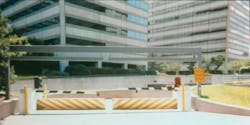Parking Focus: Vehicular Security
The vast majority of discussions involving security and parking areas focus on protecting people and property from vandalism, theft or violent crimes; yet, parking lots and garages are particularly vulnerable to vehicle-based terrorist attacks. Remember the first World Trade Center attack.
“When planning security features for a new or existing parking lot or garage, the first consideration is the level of security required for that particular facility,” says David Dickinson, senior vice president of Delta Scientific, a manufacturer of bollards, barriers and other vehicle control systems that protect facilities ranging from parking lots to military facilities.
“A parking garage for a foreign embassy or federal courthouse will require far more serious security measures than a parking lot for a mall,” he continues. “Other primary factors to consider include the frequency of vehicles moving in and out and whether there will be vehicle inspections performed or a fully automated system at the entrance.”
Regardless of the type of vehicle control system installed, Dickinson advises that any entrance to a parking garage or lot must not provide a long ramp or driveway that enables a vehicle pick up speed before arriving at the access point. Forcing vehicles to slow down by creating an S curve just before the entrance automatically creates a more secure environment.
Vehicular security equipment for parking facilities ranges from tire-puncturing devices to simple swing arm gates, to pop-up crash barriers built into the roadway that will stop errant vehicles. With any barrier system, frequency of operation is a key consideration. For example, a sliding gate would not be practical for a business that requires admitting and releasing hundreds of employee cars per day.
With vehicle barriers, the most common security breach is tailgating. When a system suspends a tailgating car, it is literally doing its job — stopping an unauthorized vehicle from entering a facility. Most vehicle barrier systems are set up to allow only one car at a time. How do you avoid these “accidents,” yet avoid weak links? Employ loop detectors. These little sensor subsystems determine when the first car has passed by and automatically and immediately drop the gate or raise the bollards.
Intelligent vehicle systems can check the velocity of an approaching vehicle, or set off an alarm if a car is coming down the wrong lane. Intelligent systems are also able to tell if a vehicle is too large to enter a parking structure, potentially saving countless dollars on structural repairs.
.




